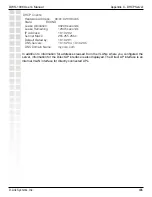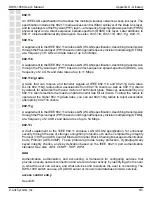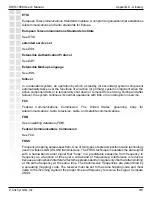
421
DWS-1008 User’s Manual
D-Link Systems, Inc.
Appendix D - Glossary
group transient key
See
GTK
.
H.323
A set of International Telecommunications Union Telecommunication Standardization Sector
(ITU-T) standards that define a framework for the transmission of real-time voice signals over
IP packet-switched networks.
hash
A one-way algorithm from whose output the input is computationally infeasible to determine.
With a good hashing algorithm you can produce identical output from two identical inputs, but
finding two different inputs that produce the same output is computationally infeasible. Hash
functions are used widely in authentication algorithms and for key derivation procedures.
HiperLAN
High-performance radio local area network. A set of wireless LAN (WLAN) communication
standards used primarily in European countries and adopted by the European
Telecommunications Standards Institute (ETSI).
HMAC
Hashed message authentication code. A function, defined in RFC 2104, for keyed hashing
for message authentication. HMAC is used with MD5 and the secure hash algorithm (SHA).
hashed message authentication code
See
HMAC
.
Hewlett-Packard Open View
See
HPOV
.
homologation
The process of certifying a product or specification to verify that it meets regulatory
standards.
HPOV
Hewlett-Packard Open View. The umbrella network management system (NMS) family of
products from Hewlett-Packard. The D-Link Mobility System RingMaster tool suite interacts
with the HPOV Network Node Manager (NNM).
HTTPS
Hypertext Transfer Protocol over Secure Sockets Layer. An Internet protocol developed by
Netscape to encrypt and decrypt network connections to Web servers. Built into all secure
browsers, HTTPS uses the Secure Sockets Layer (SSL) protocol as a sublayer under the
regular HTTP application layer, and uses port 443 instead of HTTP port 80 in its interactions
with the lower layer, TCP/IP. See also
SSL
.
Summary of Contents for DWS-1008
Page 1: ......
















































